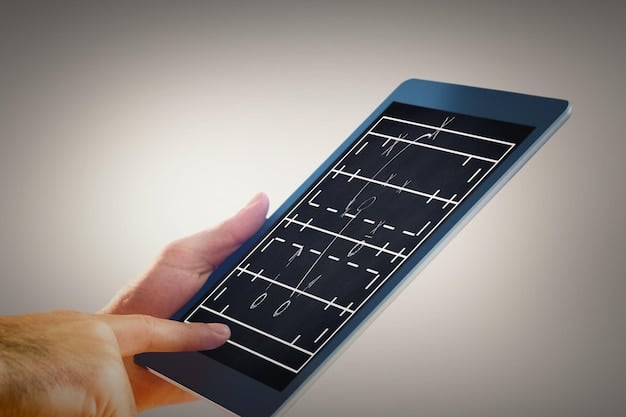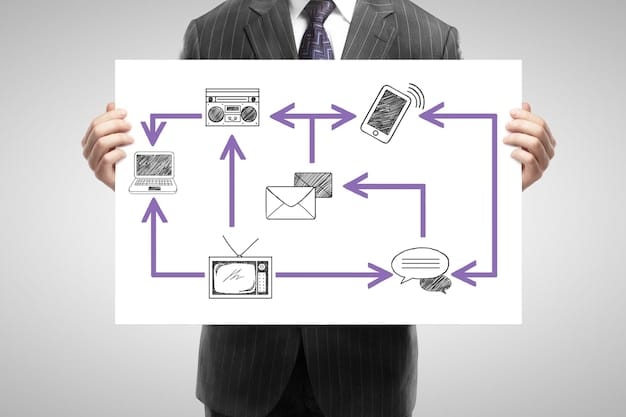Reclaim 10 Hours a Week: Eisenhower Matrix for 2025

Reclaim 10 hours a week by mastering the Eisenhower Matrix, a time management tool that prioritizes tasks based on urgency and importance, helping you focus on what truly matters in 2025.
Feeling overwhelmed? The Reclaim 10 Hours a Week: The Eisenhower Matrix for 2025 Time Prioritization offers a practical approach to regaining control over your schedule and boosting productivity.
Understanding the Eisenhower Matrix: A 2025 Perspective
The Eisenhower Matrix, also known as the Urgent-Important Matrix, is a powerful tool for time management. It provides a framework for prioritizing tasks based on their urgency and importance, enabling you to focus on what truly matters.
In 2025, with the ever-increasing demands on our time, the Eisenhower Matrix is more relevant than ever. Let’s delve into its core components and how you can leverage it to reclaim your time.
The Four Quadrants Defined
At the heart of the Eisenhower Matrix lies a simple yet effective grid, dividing tasks into four quadrants. Each quadrant represents a different priority level, guiding you in determining the best course of action.
- Quadrant 1: Urgent and Important: These tasks demand immediate attention and significantly impact your goals. Think crises, deadlines, and pressing problems.
- Quadrant 2: Not Urgent but Important: This is where strategic planning, relationship building, and self-improvement reside. These are the activities that, while not pressing, contribute most to long-term success.
- Quadrant 3: Urgent but Not Important: Often involving interruptions, meetings, and some emails, these tasks can make you feel busy without contributing much to your objectives.
- Quadrant 4: Not Urgent and Not Important: These are distractions and time-wasters, such as mindless browsing or trivial entertainment, which should be minimized or eliminated.
By understanding the characteristics of each quadrant, you can begin to categorize your tasks effectively and make informed decisions about how to allocate your time.
Ultimately, understanding the matrix is the first step in applying it. Knowing what falls into each quadrant allows for better decision-making and prioritization. This leads to a more productive and less stressful work life.
Setting Up Your Eisenhower Matrix for Success
Before you can start reclaiming those 10 hours a week, you need to set up your Eisenhower Matrix effectively. This involves creating a system that works for you, both in terms of organization and accessibility.
Let’s look at how to set up your matrix so you can start prioritizing your tasks.
Choosing Your Preferred Method
There are several ways to implement the Eisenhower Matrix, ranging from traditional pen-and-paper methods to digital solutions. The key is to choose a method that suits your personal preferences and workflow.
Here are some options:
- Physical Matrix: A whiteboard, notebook, or sticky notes can be used to create a visual representation of the matrix. This is a good option for those who prefer a tactile approach.
- Digital Matrix: Various apps and software programs offer digital templates for the Eisenhower Matrix. This is ideal for those who prefer to manage tasks on their computers or mobile devices.
Identifying Your Tasks Accurately
The success of the Eisenhower Matrix hinges on your ability to accurately identify key factors and classify your tasks according to urgency and importance. Reflect honestly on what truly matters, and what can be delayed or delegated.
Ensure items are placed into the right categories and adjust as needed. Life is fluid, so your system should be also.

Setting up your Eisenhower Matrix correctly sets the stage for effective time management. Your method should be easy to maintain and update as responsibilities shift. Doing so helps set you up for success.
Differentiating Between Urgent and Important
One of the biggest challenges in using the Eisenhower Matrix is distinguishing between what is truly urgent and what is merely important. Many tasks masquerade as urgent when, in reality, they contribute little to your long-term goals.
Learning to discern between urgency and importance is critical to making the Eisenhower Matrix work for you and reclaiming lost time.
Understanding Urgency
Urgency refers to the time sensitivity of a task. Urgent tasks demand immediate attention and often have deadlines attached to them. However, urgency does not necessarily equate to importance.
- Deadlines Drive Urgency: Many genuinely urgent tasks have strict deadlines that must be met.
- External Demands: Requests from others can create a sense of urgency, even if the task isn’t particularly important to your own goals.
Understanding Importance
Importance relates to the impact a task has on your long-term goals and values. Important tasks contribute to your overall success and well-being, even if they lack immediate urgency.
- Alignment with Goals: Important tasks directly support your strategic objectives and help you move closer to your desired outcomes.
- Personal Values: Tasks aligned with your values and principles can be considered important, even if they don’t deliver immediate rewards.
The ability to correctly differentiate between these two factors helps you assign them to the correct spot in the matrix. Making this distinction saves precious time and helps you to work with efficiency and purpose.
Becoming skilled at understanding urgency and importance leads to better decision-making when prioritizing your workload.
Applying the Eisenhower Matrix in 2025: Practical Tips
Now that you understand the principles behind the Eisenhower Matrix, let’s explore some practical tips for applying it to your daily life in 2025. The key is to integrate the matrix into your workflow in a way that feels natural and sustainable.
To effectively use the matrix, it needs to be a regular practice.
Making it a Daily Habit
To make the Eisenhower Matrix a habit, start by reviewing your tasks at the beginning of each day. This will help you prioritize your activities and make informed decisions about how to allocate your time.
- Schedule Time: Dedicate 10-15 minutes each morning to review your tasks and categorize them using the Eisenhower Matrix.
- Be Consistent: Stick to your daily review routine, even on busy days. Consistency is key to making the Eisenhower Matrix a habit.
Consistency is more important than length of time engaged. Even 5 minutes of focused effort can yield better results than 30 minutes of distracted review. Make it easy and make it often.
Leveraging Technology
In 2025, technology can be a powerful ally in implementing the Eisenhower Matrix. Explore various apps and software programs that offer digital templates and features tailored to time management.

Leveraging technology tools can make the Eisenhower Matrix easier to maintain, update, and access on the go. Experiment and find the right tools to maximize productivity.
Applying these practical tips will make the Eisenhower Matrix a sustainable and effective system. This will help you take control of your time moving forward.
Common Pitfalls to Avoid with the Eisenhower Matrix
While the Eisenhower Matrix is a valuable tool, there are several common pitfalls to avoid. Understanding these potential challenges can help you implement the matrix more effectively and maximize its benefits.
Being aware of these pitfalls will make adaptation easier and the matrix a more sustainable solution to time management.
Failing to Delegate
One of the biggest mistakes people make is trying to do everything themselves. This not only leads to burnout but also prevents you from focusing on the tasks that truly require your attention.
Delegation is a key part of the matrix and frees your attention for other important things in your work or personal life.
Overestimating Urgency
As mentioned earlier, it’s easy to mistake urgency for importance. Many tasks that seem urgent are simply distractions that prevent you from focusing on your strategic objectives.
Take a step back and evaluate tasks to see if urgency is truly warranted. Often, tasks can wait or be delegated to others freeing up your precious time.
Being aware of these common pitfalls helps to create a more effective Eisenhower Matrix plan. Avoid the pitfalls mentioned, and implementation ensures long-term success and efficiency gains.
Real-World Examples: Eisenhower Matrix in Action
To illustrate the power of the Eisenhower Matrix, let’s look at some real-world examples of how it can be used in various contexts. These examples will help you visualize the matrix in action and understand its versatility.
No matter where you apply the Eisenhower Matrix, understanding how it benefits others in various situations is helpful.
Example 1: Managing a Work Project
Consider a project manager who is juggling multiple tasks and deadlines. By using the Eisenhower Matrix, they can prioritize their activities and ensure that the most critical tasks are addressed first.
- Urgent and Important: Addressing a critical bug that is blocking progress on a key feature.
- Not Urgent but Important: Planning the project roadmap and setting milestones.
- Urgent but Not Important: Responding to routine email inquiries.
- Not Urgent and Not Important: Attending non-essential meetings or browsing social media.
Example 2: Balancing Personal Responsibilities
The Eisenhower Matrix can also be applied to personal life. Consider a parent who is trying to balance work, family, and personal needs. The matrix can help them prioritize their responsibilities and allocate their time more effectively.
- Urgent and Important: Dealing with a family emergency or attending a critical school event.
- Not Urgent but Important: Exercising, spending quality time with family, and pursuing personal hobbies.
- Urgent but Not Important: Responding to non-essential phone calls or attending social events that don’t align with their priorities.
- Not Urgent and Not Important: Mindless browsing or excessive TV watching.
These real-world examples show that the Eisenhower Matrix is helpful in numerous situations. The matrix provides a framework for organizing your time effectively.
By seeing these examples in action, it is easier to imagine yourself using the matrix for your time management needs.
| Key Point | Brief Description |
|---|---|
| ⏰ Matrix Purpose | Prioritize based on urgency and importance. |
| ✅ Quadrant Focus | Concentrate on Important, Not Urgent tasks. |
| 🤝 Delegation | Delegate urgent but not important tasks. |
| 🚫 Eliminate | Minimize non-urgent and unimportant tasks. |
Frequently Asked Questions
▼
It’s a time management tool dividing tasks into Urgent/Important, Not Urgent/Important, Urgent/Not Important, and Not Urgent/Not Important categories for effective prioritization.
▼
Urgency involves time-sensitive tasks, while importance relates to the long-term impact on your goals and values. They should be clearly distinguished.
▼
Absolutely! It’s versatile and applicable in both personal and professional settings, helping you manage responsibilities across all areas of life.
▼
Failing to delegate tasks and overestimating the urgency of lower-impact tasks causes an imbalance. Delegate effectively.
▼
Numerous apps offer digital templates tailored for the Eisenhower Matrix, making it easier to maintain, update, and access your task list digitally.
Conclusion
By mastering the Eisenhower Matrix, you can strategically prioritize and manage tasks to boost your effectiveness. Embrace its principles to reclaim your time and advance your goals confidently in 2025.





